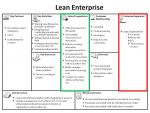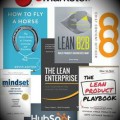You may have already heard about Lean Enterprise but, because it is a relatively new concept, you most likely haven’t yet.
What is Lean Enterprise?
 In short, Lean Enterprise is the Lean Startup approach adapted to large organisations. It has already been adopted by many large organisations such as GE, Toyota, the White House (about 4 years ago), NPOs and many startups that became large such as Zappos.
In short, Lean Enterprise is the Lean Startup approach adapted to large organisations. It has already been adopted by many large organisations such as GE, Toyota, the White House (about 4 years ago), NPOs and many startups that became large such as Zappos.
How can Lean Enterprise be used?
Lean Enterprise can be used as the guide to an entirely new innovation program. However, since most large organisation already have an innovation program, Lean Enterprise can simply build on the existing program, improve it, make it more efficient and, over time, permeate the entire organisation with a culture of innovation.
Explaining Lean Enterprise
Explaining Lean Enterprise could be a very long process given that it touches all aspects of business and will take a very distinct flavor in each or the organisation that adopts it.
When entrepreneurs or intrapreneurs (folks responsible to make innovation happen in large organisations) want to explain their projects to me, I usually ask them to describe their business model.
Hence, I’m thinking that describing Lean Enterprise’s business model is will be a good way to explain this approach to manage innovation in large organisations succinctly.
Understanding Lean Startup first
 If you are unfamiliar with the Lean Startup approach then I suggest you brush up on it. Lean Enterprise requires a very good understanding of the underlying principles as well as the capability to run Lean Startup-type experiences. There is an abundance of Lean Startup documentation online including the many Lean Startup related posts on this blog. Here is a sample of them that you can check out as a primer.
If you are unfamiliar with the Lean Startup approach then I suggest you brush up on it. Lean Enterprise requires a very good understanding of the underlying principles as well as the capability to run Lean Startup-type experiences. There is an abundance of Lean Startup documentation online including the many Lean Startup related posts on this blog. Here is a sample of them that you can check out as a primer.
- Lean Startup – The Good, The Bad and the Ugly
- Lean Startup – Reducing your commercialisation risk
- Build, Measure, Learn: Why is learning so difficult?
- Applying Lean Startup – First of a series of 8 posts
The Lean Enterprise Business Model
The image below (click to make it larger) is Baker Marketing’s version of what Lean Enterprise’s business model would look like. This version would not make for a good investors’ pitch but it’s also not its purpose. Hopefully, this business model canvas will help you to understand, at a glance, what Lean Enterprise is all about.
The Lean Enterprise Business Model Canvas
Although this canvas is pretty straight forward, I will detail the Customer Segments and Value Proposition sections of the Lean Enterprise business model for better comprehension.
Targeted Customer Segments
 The Lean Enterprise innovation approach can be used is just about any large organisation that needs to innovate. The more disruptive the innovations it produces, the more gains it will get from the Lean Enterprise approach.
The Lean Enterprise innovation approach can be used is just about any large organisation that needs to innovate. The more disruptive the innovations it produces, the more gains it will get from the Lean Enterprise approach.
For profit organisations
This segment has the most straight forward application of Lean Enterprise for innovation purposes.
There are already dozens of large organisations incorporating Lean Enterprise in their existing innovation programs to make them more efficient. It is the case of such companies as Google, GE, Intuit, Toyota, Adobe, etc.
Non profit organisations
NPOs around the world all have a common pain; they are struggling to get enough resources to achieve their goals.
In many cases they are also faced with the task to innovate in order to keep being relevant to both their users and benefactors. Lean Enterprise helps them by ensuring that all the resources they do have are used as efficiently as possible when they innovate.
Lean Enterprise also helps large NPOs develop a more innovation-friendly culture.
Public and para-public organisations
Given that efficient use of resources is a basic principle in the application of Lean Enterprise, most public organisations could benefit from its implementation greatly. Government institutions are also in dire need of catching up to economies changing at the fastest pace ever in history.
The White House initiated the Healthcare.gov portal re-design in 2011 with a Lean Startup (not yet known as Lean Enterprise) team. The embryonic project was then taken over by CGI. When CGI was unable to deliver on time and on budget, the project was reverted to the Lean Startup team. The results they achieved were so spectacular that the White House eventually adopted Lean Enterprise for all of their innovative projects. The approach also spread to other American government agencies and departments.
Aneesh Chopra, who was appointed CTO of the United States by Obama in 2009 (until 2012) was one of the catalysts in propagating the Lean Enterprise approach through the US government. [1]
Value Proposition
 This is, in part, what a large organisation can expect to obtain with the implementation of a Lean Enterprise approach to innovation that their current program may not be bringing them.
This is, in part, what a large organisation can expect to obtain with the implementation of a Lean Enterprise approach to innovation that their current program may not be bringing them.
Help innovate more efficiently
The efficiency is obtained in large part with the fact that an innovation project that is completed, within a Lean Enterprise-based innovation program, will necessarily answer the needs of its target customers/users. Hence a product/market fit or a service/user fit will be achieved every time.
Efficient use of resources (especially human) being an underlying principle of Lean Enterprise, it is therefore a constant preoccupation of the project participants.
Use existing resources more intensively
If you work in a large organisation, I am certain you are aware of either unused resources or resources not fully used that can be put to contribution in innovation projects. If not, I suggest you ask and snoop around. You will find some in no time. The infusion of entrepreneurial attitude, brought by Lean Enterprise, makes using these resources second nature.
Build on existing innovation programs/practices
Lean Enterprise is based on principles, tools and techniques borrowed from many existing and proven management theories such as:
- Lean production
- Customer development
- Agile development
- Design Thinking
Most innovation programs already make use of the principles, tools or techniques of some of these theories. Lean Startup implementation can ‘’surf’’ on these existing programs in an organisation and add to them. This greatly flattens the learning curve and is more easily adopted.
Implementing a Lean Enterprise approach to innovation is like any other change management program. It must be done incrementally, ensuring all are onboard.
Increase speed to market of innovations
Lean Enterprise is based on rapid iteration testing of the various parts of a business model until you reach a product/market fit or service/user fit[2].
The approach has a built-in control mechanism to ensure innovation teams don’t go astray, lose focus or momentum.
Pivot quickly on ideas with no positive ROI
All of the products or services that get to market with a Lean Enterprise approach are successful. This, however, doesn’t mean that these successful products or services look anything like what was imagined initially.
Lean Enterprise does not prevent or fix product or service ideas that would flop in the market. It does however quickly show which ideas need to be discarded thus avoiding the waste of resources to bringing them to market. Luckily, most ideas simply need a few pivots (okay many pivots) to achieve success with their markets.
Better manage innovation financing risks
The use of innovation accounting in Lean Enterprise innovation programs allows for incremental financing with a known risk coefficient of each of the projects increments.
It bridges the gap between corporate innovators and financial managers.
You can read more about innovation accounting in these previous posts.
- Is Innovation Accounting Going to Change the Way we Do Business?
- How is Innovation Accounting Done?
- Innovation Options: The Game Changer
Creates innovation culture in the long run
The real prize, at the end of the journey of implementing Lean Enterprise, is the creation of a true culture of innovation.
Some of the most important barriers today in achieving a true organisation-wide culture of innovation are the following:
- Mistakes are neither welcome nor tolerated
- Resources (human, financial, physical, etc.) are kept in silos
- Decision making power is diluted (with a heavy weight at the top of the pyramid)
- Over-abundant and rigid processes that result in slow reactions to market changes
The Lean Enterprise approach to innovation, intrinsically, removes those barriers.
As any other change management program, Lean Enterprise takes time, effort and commitment. Commitment from the innovation project champions but also from top management. Although still in its infancy, the Lean Enterprise approach shows promise of integrating innovation into large organisation’s main stream of business instead of treating it like a special cousin, as it is now.
If you want to learn more about Lean Enterprise and its application, you can pre-order Eric Ries’ new book due out in the fall, called TheStartup Way.
If you have a Lean Startup Circle community in your area, you can contact the organisers to locate experienced coaches or attend their meetups and see how entrepreneurs and intrapreneurs can help each other innovate more efficiently.
[1] This hour-long talk with Aneesh Chopra explains how Lean Enterprise came to be in the US governement
[2] Characterised by a sharp increase in the sales or adoption growth for a sustained period.











